
Caryophyllaceae, commonly called the pink family or carnation family, is a family of flowering plants. It is included in the dicotyledon order Caryophyllales in the APG III system, alongside 33 other families, including Amaranthaceae, Cactaceae, and Polygonaceae. It is a large family, with 81 genera and about 2,625 known species.

Verbascum is a genus of over 450 species of flowering plants, common name mullein, in the figwort family Scrophulariaceae. They are native to Europe and Asia, with the highest species diversity in the Mediterranean.

Ajuga, also known as bugleweed, ground pine, carpet bugle, or just bugle, is a genus of 40 species annual and perennial herbaceous flowering plants in the Ajugeae tribe of the mint family Lamiaceae, with most species native to Europe, Asia, and Africa, but also two species in southeastern Australia. They grow to 5–50 cm tall, with opposite leaves.

Calystegia is a genus of about 25 species of flowering plants in the bindweed family Convolvulaceae. The genus has a cosmopolitan distribution in temperate and subtropical regions, but with half of the species endemic to California. They are annual or herbaceous perennial twining vines growing 1–5 m tall, with spirally arranged leaves. The flowers are trumpet-shaped, 3–10 cm diameter, white or pink, with a sometimes inflated basal epicalyx.

Gladiolus is a genus of perennial cormous flowering plants in the iris family (Iridaceae).
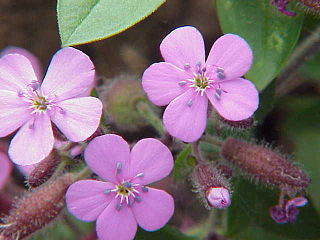
Saponaria is a genus of flowering plants in the family Caryophyllaceae, native to Asia and Europe, and are commonly known as soapworts. They are herbaceous perennials and annuals, some with woody bases. The flowers are abundant, five-petalled and usually in shades of pink or white. The genus is closely related to Lychnis and Silene, being distinguished from these by having only two styles in the flower. It is also related to Gypsophila, but its calyx is cylindrical rather than bell-shaped.

Brassica nigra, or black mustard, is an annual plant cultivated for its black or dark brown seeds, which are commonly used as a spice. It is native to tropical regions of North Africa, temperate regions of Europe, and parts of Asia.

Muscari is a genus of perennial bulbous plants native to Eurasia that produce spikes of dense, most commonly blue, urn-shaped flowers resembling bunches of grapes in the spring. The common name for the genus is grape hyacinth, but they should not be confused with hyacinths. A number of species of Muscari are used as ornamental garden plants.

Isatis is a genus of flowering plants in the family Brassicaceae, native to the Mediterranean region east to central Asia. The genus includes woad. Due to their extremely variable morphology, the Asian species in particular are difficult to determine; the only reliable diagnostic feature is the ripe fruit. They are (usually) biennial or perennial herbaceous plants, often bluish and hairless or downy hairy with the upright stem branched.

Moenchia erecta, the erect chickweed or upright chickweed, is a small annual plant in the family Caryophyllaceae. It can grow to over 10 cm in height, but it is usually smaller. It has blue-green glaucous leaves, and small, delicate white flowers. The sepals are longer than the petals, green and bordered in white. The plant is a common pasture weed native to Europe. It has been introduced elsewhere, including Australia and western North America, but it is not particularly invasive or competitive.

Petrorhagia is a small genus of annual and perennial plants of the family Caryophyllaceae, mostly native to the Mediterranean region. It is low-growing with wiry stems and narrow, grass-like leaves. The flowers are small, in clusters similar to members of the genus Dianthus, in pink, lilac, or white. Petrorhagia saxifraga is the tunic flower or coat flower, similar to baby's breath, but shorter, and used in rock gardens.
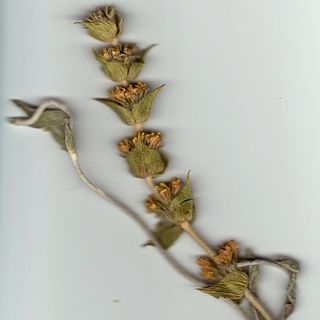
Sideritis, also known as ironwort, mountain tea, and shepherd's tea, is a genus of flowering plants known for their use as herbal medicine, commonly as an herbal tea. They are abundant in Mediterranean regions, the Balkans, the Iberian Peninsula and Macaronesia, but can also be found in Central Europe and temperate Asia.
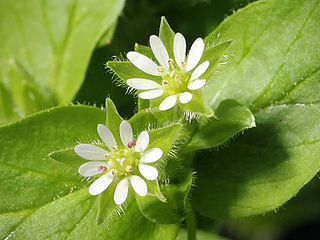
Stellaria media, chickweed, is an annual and perennial flowering plant in the family Caryophyllaceae. It is native to Eurasia and naturalized throughout the world. This species is used as a cooling herbal remedy, and grown as a vegetable crop and ground cover for both human and poultry consumption. It is sometimes called common chickweed to distinguish it from other plants called chickweed. Other common names include chickenwort, craches, maruns, and winterweed. The plant germinates in autumn or late winter, then forms large mats of foliage.
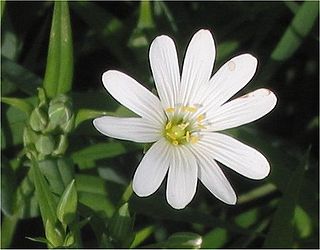
Rabelera holostea, known as greater stitchwort, greater starwort, and addersmeat, is a perennial herbaceous flowering plant in the family Caryophyllaceae. It was formerly placed in the genus Stellaria, as Stellaria holostea, but was transferred to the genus Rabelera in 2019 based on phylogenetic analyses. It is the only species in the genus Rabelera. Greater stitchwort is native to Western and Central Europe, including the British Isles.

Holosteum is a genus of plants in the family Caryophyllaceae with 3 or 4 species native from southern Europe through central and south western Asia and in Africa. They are herbs with an annual life span, some growing as winter annuals. They have slender roots and thin stems that are upright or ascending. The genus name was given by Linnaeus, and named because of the sprawling nature of the plants: Greek holos, meaning whole or all, and osteon, meaning bone, because of the frailty of the plant.
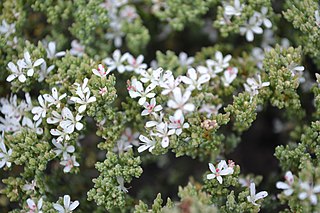
Frankenia is the only genus in the Frankeniaceae family of flowering plants. Other genera have been recognized within the family, such as Anthobryum, Hypericopsis and Niederleinia, but molecular phylogenetic studies have consistently shown that they all belong inside Frankenia. Frankenia comprises about 70–80 species of shrubs, subshrubs and herbaceous plants, adapted to saline and dry environments throughout temperate and subtropical regions. A few species are in cultivation as ornamental plants.

Subgenus Xiphium is a subgenus of Iris. If considered a separate genus from Iris, it is known as genus Xiphion.

Acanthophyllum is a genus of flowering plant in the family Caryophyllaceae with about 75 species, spread in the Irano-Turanian area.

Iris attica, the Greek iris, is a plant species in the genus Iris, it is also in the subgenus Iris. It is a rhizomatous perennial, from the mountains of the Balkans in Europe, within the countries of Greece, former Yugoslavia, Turkey and North Macedonia. It has sage green or grey-green leaves, that are sickle-shaped, a stout short stem and 2 variable flowers, in shades from yellow to purple. They have a white or blue beard. It is often called Iris pumila subsp attica, but is classified in most sources, as a separate species, although it is closely related to Iris pumila, as a possible parent plant. It is cultivated as an ornamental plant in temperate regions.

Iris suaveolens is a plant species in the genus Iris, it is also in the subgenus Iris. It is a rhizomatous perennial, from Eastern Europe, ranging from the Balkans to Turkey. It has short, sickle shaped or curved, blue-green or greyish green leaves, a slender simple stem, with 1 or 2 fragrant spring blooming, flowers, between yellow and purple, with white or yellow beards. It was once known as Iris mellita, until that was re-classified as a synonym of Iris suaveolens. It is cultivated as an ornamental plant in temperate regions.




















